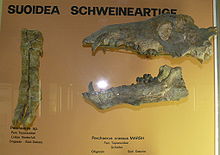Perchoerus
Appearance
| Perchoerus | |
|---|---|

| |
| Fossils in Berlin | |
| Scientific classification | |
| Domain: | Eukaryota |
| Kingdom: | Animalia |
| Phylum: | Chordata |
| Class: | Mammalia |
| Order: | Artiodactyla |
| Family: | Tayassuidae |
| Genus: | †Perchoerus Leidy,1869 |
| Species | |
| |
| Synonyms[1] | |
| |

Perchoerusis an extinct genus ofsuinefrom theEoceneandOligoceneof North America. Three species are known.[1][2]While often considered to be apeccary,other studies have recovered it to be a basal suine outside of either peccaries orSuidae.[3]The oldest known species ofPerchoerusisP. minor,which was only the size of a housecat.It is known from skull and tooth material. The laterP. nanusof theOrellangrew larger and is known from a skull and lower jaw. The latest and largest species wasP. probusof the Oligocene (32-30 mya). It was much larger (about as big as living peccaries) and known from more remains than the other species.[1][4]
References
[edit]- ^abcProthero, Donald R. (2021).THE SYSTEMATICS OF NORTH AMERICAN PECCARIES (MAMMALIA: ARTIODACTYLA: TAYASSUIDAE) By · 2021.New Mexico Museum of Natural History and Science. pp. 6–8.
- ^Prothero, Donald R. (2009). "THE EARLY EVOLUTION OF THE NORTH AMERICAN PECCARIES".Museum of Northern Arizona Bulletin.65:509–542.
- ^Parisi Dutra, Rodrigo; Casali, Daniel de Melo; Missagia, Rafaela Velloso; Gasparini, Germán Mariano; Perini, Fernando Araujo; Cozzuol, Mario Alberto (2016-09-13)."Phylogenetic Systematics of Peccaries (Tayassuidae: Artiodactyla) and a Classification of South American Tayassuids".Journal of Mammalian Evolution.24(3): 345–358.doi:10.1007/s10914-016-9347-8.hdl:11336/54840.ISSN1064-7554.
- ^Prothero, Donald R.; Williams, Mary Persis (2016).The Princeton Field Guide to Prehistoric Mammals.Princeton University Press. pp. 157–158.ISBN9781400884452.

